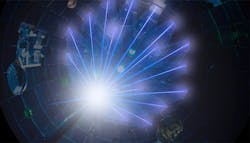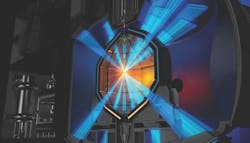It’s time for a fusion energy roadmap
Editor's note: Listen to our podcast interview with Hagen Zimer below, which we released on January 14, 2025.
Scientists have observed a global warming trend since the mid-20th century and attribute it to humans. The warming created by the atmospheric greenhouse gases that trap heat energy radiated from the Earth toward space is real and cannot be denied. It is also well known that the major human contribution to greenhouse gas emission results from burning fossil fuels to generate electricity and heat. Global warming and an increasing energy demand, boosted by a growing world population with larger demands for electricity, opens an energy gap of about 40 terawatts in 2050, and which from today’s perspective cannot be filled by current clean or renewable energy alone.
The challenge of clean nuclear energy
Nuclear energy obtained from the fission of uranium or other heavy elements is a generally clean energy source, but as a solution it suffers from the safe storage of long-lasting radioactive waste as well as potential nuclear disasters and uncontrolled chain reactions due to malfunctioning. Due to these considerations, the most recent progress in fusion energy research has gained much public and economic attention. Fusion energy technology promises to provide safe and greenhouse-gas-free clean energy without the disadvantages of volatile availability like renewables or the previously mentioned threats to humans.
In the broad technical landscape of fusion energy research done since 2021, there has been disruptive and revolutionary progress in laser-driven inertial confinement fusion (ICF) from the U.S. National Ignition Facility (NIF) at Lawrence Livermore National Laboratory in California. For the first time, researchers demonstrated alpha-particle self-heating in a laser pre-compressed deuterium-tritium fuel, similar to fusion conditions in our sun, and obtained more output fusion energy than the optical laser energy provided into the target. The laser energy input was about two megajoules, which requires a large-scale laser facility of tremendous initial and running costs.
Now that ICF-driven fusion has been successfully demonstrated, the big question is: Can it be commercialized? And will it be reliable and cheap enough to meet future energy needs and prices? Although startups seek investments and private-public partnerships, we observe a hesitation by investors because of yet unsolved technical challenges resulting in uncertain roadmaps and the significant upfront capital expenditure within the range of multiple billion dollars that would be needed. The supply chain industry generally sees an attractive future business opportunity in ICF power plants, if it works. But they are hesitant as well since longer-lasting roadmaps are not yet described or are not truly practical yet.
Now is the time to develop a more realistic roadmap for ICF—with clear milestones on reasonable timelines to not only address the technical challenges but also create/align an international network of political collaboration.
Growing fusion knowledge
The physics of nuclear fusion has been understood since the mid-20th century and has been described to further the understanding of the driving energy source of stars like our sun.
Very briefly, it is the fusion of two light hydrogen atomic nuclei—deuterium and tritium—into the heavier element helium, also called an alpha particle. Under conditions of extreme pressure and tens of millions of degrees in temperature, the light hydrogen atoms get so close to each other that the short-ranging attracting atomic force between them gets larger than the long-reaching electromagnetic force due to their Coulomb repulsion. This happens at a relative kinetic energy of the constituents to each other of about 10 kiloelectronvolts. Once fused together to form a helium atom, the remaining protons and neutrons experience a larger negative binding energy than those of the initial light hydrogen atoms, and about 17.6 megaelectronvolts (MeV) are released. Compared to chemical reactions, this energy release is about one million times larger. The larger fraction of the energy, about 14 MeV, is carried away by the emitted neutron, whereas 3.5 MeV remain with the created helium atom.
On Earth, there are no natural temperature and pressure conditions like in the sun. In magnetic confinement fusion, researchers enclose a low-density plasma within a magnetic vessel, but the difficulty is that the temperature may reach 200 million Kelvin on timescales ranging from a few seconds to minutes. In contrast, in laser-driven ICF, researchers compress a small plastic pellet, which contains micrograms of the deuterium-tritium fuel, with ultrahigh pressures and temperatures similar to the conditions in the sun—but only for brief, nanosecond timescales. Both approaches, if successful, represent safe and clean fusion energy sources. But there is still a long way to go before we will see a real fusion power plant, regardless of the technological approach. It will certainly take at least another 10 to 15 years of massive financial investment and further technological breakthroughs before we see the first power-plant-like demonstrations.
One of the greatest challenges for laser-induced fusion will be building a demonstration facility with governmental and private-public funding—one that seeks to purely investigate and develop the technology toward energy use. Today, laser-driven fusion facilities like NIF or the French MEGAJOULE project are primarily thought to be conducting nuclear-weapon-based fusion research within military research environments and programs. Obviously, the progress, knowledge, and discoveries of such work can only be shared publicly within certain boundary conditions and restrictions.
A large-scale civil laser fusion facility is needed to gain traction and focus the research on the topics that are relevant to building a real power plant in the future. The goals must be to gain knowledge of the fusion processes in such reactors, to optimize the processes toward the highest energy extraction efficiency at the lowest costs (to be economically competitive), to conduct materials research, and to develop possible power plant concepts. The knowledge gained there will be incorporated into demonstration power plants that will test continuous grid operation. Only then will the first commercial fusion power plants be built.
Viable laser-based fusion
The human use of fusion energy is a unique technological endeavor—and the financial and technological effort it will require is enormous. Before a laser for fusion power plants can be developed, there must be a concerted effort by industrial companies and a functioning ecosystem that goes beyond ambitious startups. No single company will be able to achieve the industrial application of fusion energy on its own.
As a leading supplier of lasers, the key technology for ICF, TRUMPF has the technological capability and internal supply chain to build the highly complex lasers needed for fusion power. We have the competences and skills required to industrialize such lasers and build them at the lowest possible cost—and have already successfully proven this by delivering high-power lasers into the emerging field of EUV lithography. With more than two decades of experience developing and marketing diode laser pump sources for industrial solid-state lasers, our expertise covers the entire value chain from materials to full environmental and reliability testing to integration into the laser system.
But laser fusion requires large numbers of laser diodes. Even an initial fusion demonstration facility would need multiple tens of diode-pumped high-energy kilojoule lasers of the same kind. So industrialization and standardization of these lasers would make sense and generate business—even in this early phase.
However, as mentioned, the lack of a clear and consistent roadmap with financial long-term commitments toward a first demonstrator facility that will eventually prove the robustness and economics of ICF simply does not exist and therefore neither does a vision for any kind of commercial business case. The net effect is that we have not yet started the required and costly R&D programs on a large-scale to supply these lasers when they are needed in five to seven years. For this reason, TRUMPF has so far been reluctant to get involved.
Until significant and clear roadmap commitments are there, TRUMPF is participating in smaller governmental fusion research programs in Germany and the United States, including the Science and Technology Accelerated Research for Fusion Innovation and Reactor Engineering (STARFIRE). The STARFIRE research hubs are a project with the U.S. Department of Energy, which has approved $42 million in funding for three new laser fusion centers. This funding is intended to help researchers develop technology into an environmentally friendly source of energy for future generations. Along with academic institutions, U.S. laboratories, and other industrial companies, TRUMPF's laser expertise can help advance research into the fundamental challenges of fusion energy as an economically viable method of low-carbon energy production.
The common goal of these research programs is to develop a viable plan to build an inertial fusion power plant. For an inertial confinement fusion power plant to produce more energy than is needed to operate the laser, we would need to replace the inefficient flash-lamp pumped laser sources with modern highly efficient diode-pumped lasers. Along with our consortium partners, we will address the key issues of scaling, cost reduction, and standardization of diode pump sources.
Development of fusion energy is at a decisive point. With a clear roadmap that promotes collaboration between industry, research, and politics, we can unlock the enormous potential of this clean and virtually inexhaustible energy source. The next major step—the development of a working beamline using diode-pumped lasers and a multi-beamline science demonstrator—must come soon to drive further fusion energy research on a large scale. TRUMPF is ready to make a decisive contribution with its technological expertise and innovative strength. Together we can overcome the challenges and make fusion energy a viable and economically competitive energy source of the future. It is time to set the course for a sustainable and secure energy future.
About the Author
Hagen Zimer
Hagen Zimer is CEO of Laser Technology and Member of the Managing Board of TRUMPF SE + Co. KG (Ditzingen, Germany).

